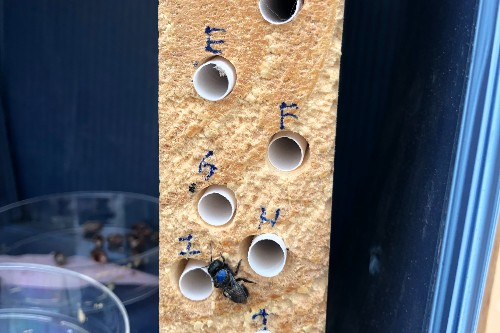The novel pesticide, flupyradifurone, is thought to pose less risk to pollinators and consequently has been licenced globally for use on bee-visited crops.
However, research by scientists at the University of Bristol and the University of Texas at Austin, discovered, contrary to their expectations, that the chemical was lethal in the bees Osmia lignaria exposed to pesticide-treated wildflowers.
They also found a number of sublethal effects. Seven days post-application, bees released into the pesticide-treated plants were less likely to start nesting, had lower survival rates, and were less efficient foragers, taking 12.78% longer on average to collect pollen and nectar than control bees.
Lead author Harry Siviter from Bristol’s School of Biological Sciences explained: “These results demonstrate that exposure to flupyradifurone poses a significant risk to important pollinators and can have negative impacts on wild bees at field-realistic concentrations.”
Bees are vital pollinators of crops and wildflowers. Neonicotinoid pesticides can have significant negative impacts on pollinators which have led to high profile restrictions in their use in the EU, and other regions, which has increased the demand for ‘novel’ insecticides.
“Due to limitations in formal ecotoxicology assessments, there is an urgent need to evaluate potential replacement crop treatments,” added Harry.
“These results caution against the use of novel insecticides as a direct replacement for neonicotinoids.
“Our findings add to a growing body of evidence demonstrating that pesticide risk assessments do not sufficiently protect wild bees from the negative consequences of pesticide use.”
To avoid continuing cycles of novel pesticide release and removal, with concomitant impacts on the environment, the team say a broad evidence base needs to be assessed prior to the development of policy and regulation.
Harry said: “Restricting the use of commercial pesticides containing flupyradifurone to non-flowering crops would be sensible while more research is conducted.
“In the long-term, as we are already seeing in the EU, a move towards a more holistic approach to risk assessment that considers the biology of non-Apis bees is required to better protect pollinators from the unintended negative impacts of pesticides.”
The team now plan to extend their research to measuring the impact of exposure through soil on solitary bees.
Paper
‘A novel pesticide has lethal consequences for an important pollinator’ by Harry Siviter et al in Science of the Total Environment

